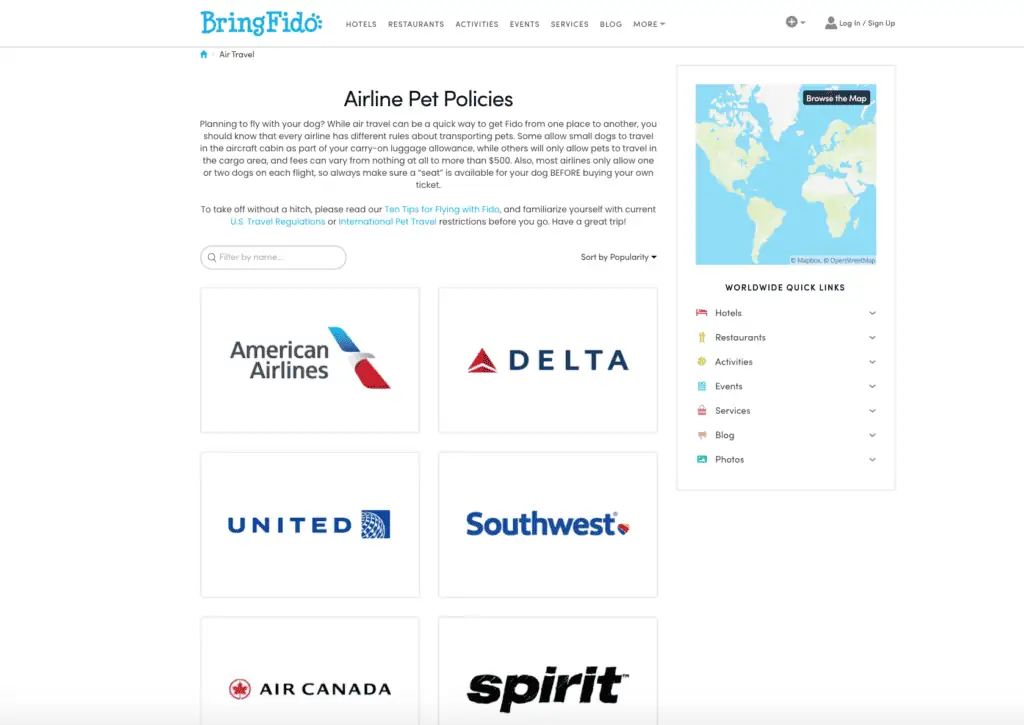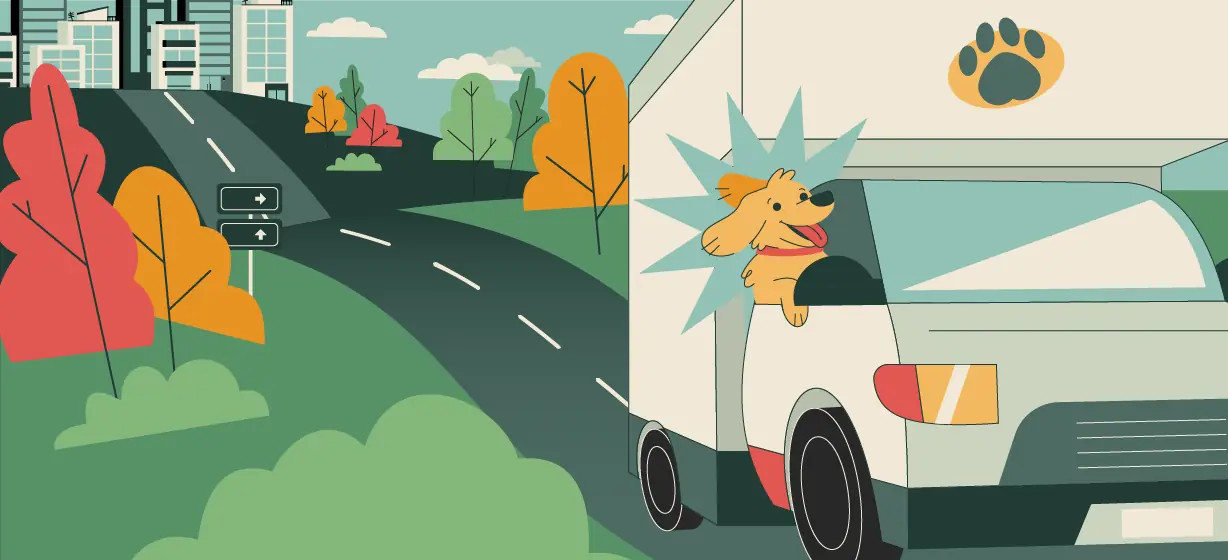The Ultimate Guide To Moving Long Distance With Pets
Posted in: I'm Moving, Kids & Pets, Long Distance Moving AdviceThose of us with precious fur babies only want the best for them. If you’re moving long-distance, bringing Fido or Mittens along for the journey might present new stressors you never even considered before.
Knowing this, who better to ask about the best way to move long-distance with pets than the very people we rely on to help us keep them healthy and happy? We reached out to several veterinarians and moving pros and compiled their best insights for how to relocate a pet.
Table of Contents
Step 1: You Actually Gotta Prep Your Pet for Moving
You know you’re moving, right? Your pet doesn’t.
It’s best to avoid changing anything about your daily routine that doesn’t absolutely need to be changed, according to Jennifer Coates, a veterinarian who serves on the advisory board for Pet News Daily. Without realizing it, a lot of people are accidentally contributing to a much more difficult move.
Here is her professional advice for pet prep:
Don’t switch your pet to a new diet in the weeks surrounding a move. Sudden diet changes can lead to upset stomachs, she said.
Plan to bring enough of their typical food for the duration of the trip. This is so you don’t have to purchase something new and different along the way.

Visit your vet ahead of time to explicitly discuss the move. “Talk to your veterinarian if your pet has a history of anxiety or motion sickness,” Coates said. Nervous pets may benefit from calming nutritional supplements or pheromone sprays or collars. “A veterinarian can prescribe sedatives for a severely anxious pet, but perform a trial run before the big trip to see how your pet reacts to the medication,” Coates added.
Double-check that your pet is up-to-date on all their vaccinations. It’s a good idea to get a copy of their vaccination records to have handy while you’re traveling.
Moving far away?
Do it cheaper.
MovingPlace can save up to 40% compared to traditional interstate moving companies. Click here to learn how.
Step 2: Check Local Pet Laws Where You’re Going
Before you hit the road or sky, you actually need to make sure your pet is allowed to cross state borders there, and that you have the proper documentation.

“Any animal that crosses a state’s border, whether by car, plane, or train, needs to have an accompanying health certificate,” says Dr. Michelle Burch, who holds a doctorate in veterinarian medicine and advises for Safe Hounds Pet Insurance.
Every state has different laws and regulations depending on the species, Burch explains. (For example, if you’re moving to California with a dog, you’ll only need proof of its rabies vaccination.)
Talk to your vet about the requirements where you’re moving and look up local requirements on the USDA website.
If you end up needing a health certification for your pet, Google a USDA accredited veterinarian residing within your STARTING location. They can officially certify you will not be transmitting contagious and reportable diseases to your new area.
Step 3: Pick the Best Travel Option for Them
If you’re thinking the movers you hire can help out with moving your furry friends, think again. “The movers moving your furniture won’t—and shouldn’t—handle animals at all,” advises Nicole Ellis, a certified professional dog trainer and pet lifestyle expert with Rover.com. This means you’ll need to personally escort your pet to the new destination, and how you do it will necessarily change your approach.
Moving Truck
If you’re driving some kind of moving truck, you should ideally have them in the front cab with you since there’s no climate control in the storage area. Plus, that way you can keep an eye on them and ensure they’re secured.
If you’re staying in hotel rooms, make sure to call and book pet-friendly hotels or motels ahead of time!
Plane
If you’re flying, you may be able to keep your dog or cat with you in the cabin, depending on their size and breed, obviously. Airlines have very different rules regarding animal and carrier size limits. Generally, though, you’ll need an airline-approved soft-sided carrier that can fit under the seat in front of you with enough room for your pet to stand up and turn around.

Larger animals will likely need to travel in the cargo area below the plane (unless they are a service animal). While generally safe, it’s important to proceed with caution if you go this route.
Try to book a direct flight so they don’t spend extra time sitting in the cargo hold area or so they don’t need to be transferred to another plane. Provide water and food, and consider securing some extra food to the outside of the crate in case there is a delay.
If possible, book a flight during the spring or fall, when the weather is mildest, to avoid exposing them to extreme temperatures. And when boarding, have the crew let the pilot know there’s an animal onboard below, so they can keep the cargo temperature and pressure top of mind.
Keep in mind that certain animals just shouldn’t travel by cargo, such as brachycephalic dog breeds (aka smushy faces), which have more respiratory issues. Talk to your local veterinarian.
Pet Relocation Service
If you’re unable to drive or fly to your new destination with your pet by your side, you might want to consider hiring a pet relocation service (here’s a list of the best ones).
These companies will ship your pet by ground or air, and can usually handle just about any type of pet—from dogs and cats to lizards and livestock. This can also be a good option if you have an animal that’s banned by most airlines, such as a snub-nosed (or so-labeled “dangerous”) dog breed.
Pet shipping companies can also be convenient because they arrange for the proper paperwork to transport your animal and stay up-to-date on local travel restrictions.
If you are using a pet relocation service, you definitely want to ensure they have these things in place before you hire them:
- A contract: It’s a good idea to have an official contract in place, which Ellis notes all the decent shippers offer. “Not having terms and conditions that outline the hauler’s responsibilities leave the consumer vulnerable,” she says. Also, verify the service’s insurance coverage.
- Proper crates: Animals should be transported in crash-tested crates, not just meal wire versions.
- Frequent pit stops: Ask how often the driver stops to let your pet go potty and hydrate. Ideally, they should stop every 3-4 hours.
- Strong communication: The driver should check in with you during transit to let you know how things are going. Establish how and when you should be contacted before dropping off your pet.
- “Pawsitive” reviews: Before committing to a company or service, be sure to read reviews on multiple sites and social media to see what kind of experience other customers have had.
And don’t be afraid to ask questions. “Ask who is actually doing the driving and ask for pictures of their rigs,” Ellis advises.
Also ask about what route they plan to take, including layovers, and for references (and actually take the time to call them). “Any decent shipper should be able to layout 10-15 references in a matter of minutes, and I don’t think it’s unreasonable to ask for that many,” Ellis says. “This is your furry family member we’re talking about, so you really can’t be too cautious and diligent.”
How much are pet relocation services?
Keep in mind, however, that shipping a pet is pretty expensive. Air shipping can cost around $2,000-$3,000, while ground shipping can cost upwards of $5,000-$6,000 (especially if the animal is being transported over a few thousand miles).
Moving far away?
Do it cheaper.
HireAHelper.com can save you up to 40%, compared to traditional interstate van lines.
Compare our long distance moving company options.
Step 4: Expert Advice for Keeping Your Pets Safe and Happy While Moving
No matter how you travel, it’s important to take a few steps to ensure the safety of your pet. Here are a few more things the pros told us:
Never leave your pet alone in the vehicle. It may be tempting to leave your animal in the car while you run a few errands or grab lunch, but it’s a risky move that’s not worth it. “Temperatures can quickly rise to dangerous levels even with the windows left partially open,” Coates told us. Plus, there’s a chance your pet could injure itself (especially if it’s stressed out) or even be stolen!
Bring along the scent of home. Moving will be stressful for an animal, which can lead to issues with eating, going potty, injuries, and more. (Not to mention, a long-distance drive to the soundtrack of whining or yowling is not exactly pleasant.) To help your dog or cat stay calm, put something that smells like home in their crate, like an unwashed towel, blanket, or t-shirt.
Keep a parasite preventative handy. If your pet takes certain medicines or supplements, make sure you have an ample supply for the trip. Coates adds that dogs and cats should be on a veterinarian-recommended parasite preventative that protects against heartworms, fleas, and ticks.
Tag ‘em. If the worst were to happen and your pet somehow escaped while traveling, you want to make it as easy as possible to track them down. “Make sure your pet’s ID tag and microchip information is up-to-date,” Coates said. It’s also a good idea to have a few pictures of them on hand, just in case.
Buckle up. Just as you (hopefully) wear a seatbelt during transit, it’s important to secure your pet, too. Ellis recommended using a dog harness from Sleepypod, or a crash-tested carrier.
Pack seven days of additional food and treats. To avoid disruptions to your pet’s diet, bring more than enough food for the trip. “I recommend packing enough food for the entire length of the move process, including an additional seven-day supply,” Burch said. “An additional reserve will come in handy if you have delays in your transition.”
(Usually) Bring their toys. Another way to keep your pet calm and distracted is by bringing along a couple of toys they love. “Your pet may not play with the toy during the transition, but this will help to reduce stress,” Burch said. The exception is if they are traveling by plane cargo—avoid putting any hard items inside with them, which can bounce around and potentially injure them.
Specific Moving Tips by Species
How to move with a dog
Dogs are creatures of habit and routine. Messing with that routine or introducing foreign items and people to their space can really freak them out. That’s why it’s important to desensitize them to moving boxes, dollies, and above all, their travel crate. In the days leading up to your move, give your dog treats while they’re around these items to create a positive association.
It’s also important to keep their regular routine intact as much as possible. For instance, try to stick to the same feeding times, and take potty breaks when they’re used to going out.
Dogs also need plenty of exercise and mental stimulation, otherwise, they get bored and anxious. Try to work in some time for physical activity. And while Sparky is stuck in his crate, provide brain games like a stuffed Kong toy, or treat ball.
 How to move with a cat
How to move with a cat
Moving with a cat can be a bit tougher than with a dog, since they generally aren’t trained to sit, stay, or walk on a leash. Your kitty will probably spend a lot of time in its carrier while moving, so it’s crucial to make sure they’re comfortable being in there. It can help to start giving your cat its meals inside the carrier before move day.
There’s also the issue of potty breaks. You’ll need to pack their litter, litter pan, and scooper.
“I also recommend pheromone supplementation with sprays or collars to reduce stress during the move,” Burch advises. “For cats, I recommend Feliway. The products replicate the mother’s pheromone produced to soothe her kittens.”
How to move with a bird
If you’re moving a bird, it’s especially important to ensure it doesn’t get stressed out. You’ll want to keep them nearby if possible, and keep an eye out for changes to their feathers, appetite, and behavior.
If traveling by car, keep their carrier in the back seat. If you’re in an accident, the passenger airbag could injure them. Try to keep the air temperature the same as their normal habitat, and bring a blanket to put over the carrier to prevent your bird from getting too much direct sunlight.
 How to move with a reptile
How to move with a reptile
Air travel is particularly difficult and stressful for reptiles, and it’s not recommended unless “absolutely necessary”. (That’s according to Georgina Ushi, a veterinarian, and writer at WeLoveDoodles.)
If you do, inspect the cargo hold to make sure it will be a safe and comfortable place for your reptile (it should be pressurized, the temperature should be safe, etc.). “Airlines will accept most reptiles, but only as cargo,” Ushi said. If you are traveling by cargo, be sure to use a carrier approved by the airline for your type of pet. “For larger reptiles, such as iguanas and larger snakes, a pet carrier may be sufficient.”
How to move with fish
Fish can be individually scooped into a 5-gallon container with their aquarium water. Ushi said it’s a good idea to contact an aquatic veterinarian to help you determine if you need to add any supplements in the water to help the fish during the trip. “I know some people who use sedation to help keep the fish free of stress and conserve oxygen,” she explained.
You’ll want to keep the environment dark (or at least heavily shaded) and cool. Obviously, your fish will be vulnerable in this situation, so you want to minimize the amount of time they spend in their temporary homes as much as possible.
Once you arrive at your location, the aquarium should be the first thing you unpack. “Remember that you will need a functioning aquarium when your fish arrives, as it is already in the water without a filter,” Ushi said.







 How to move with a cat
How to move with a cat
 How to move with a reptile
How to move with a reptile


